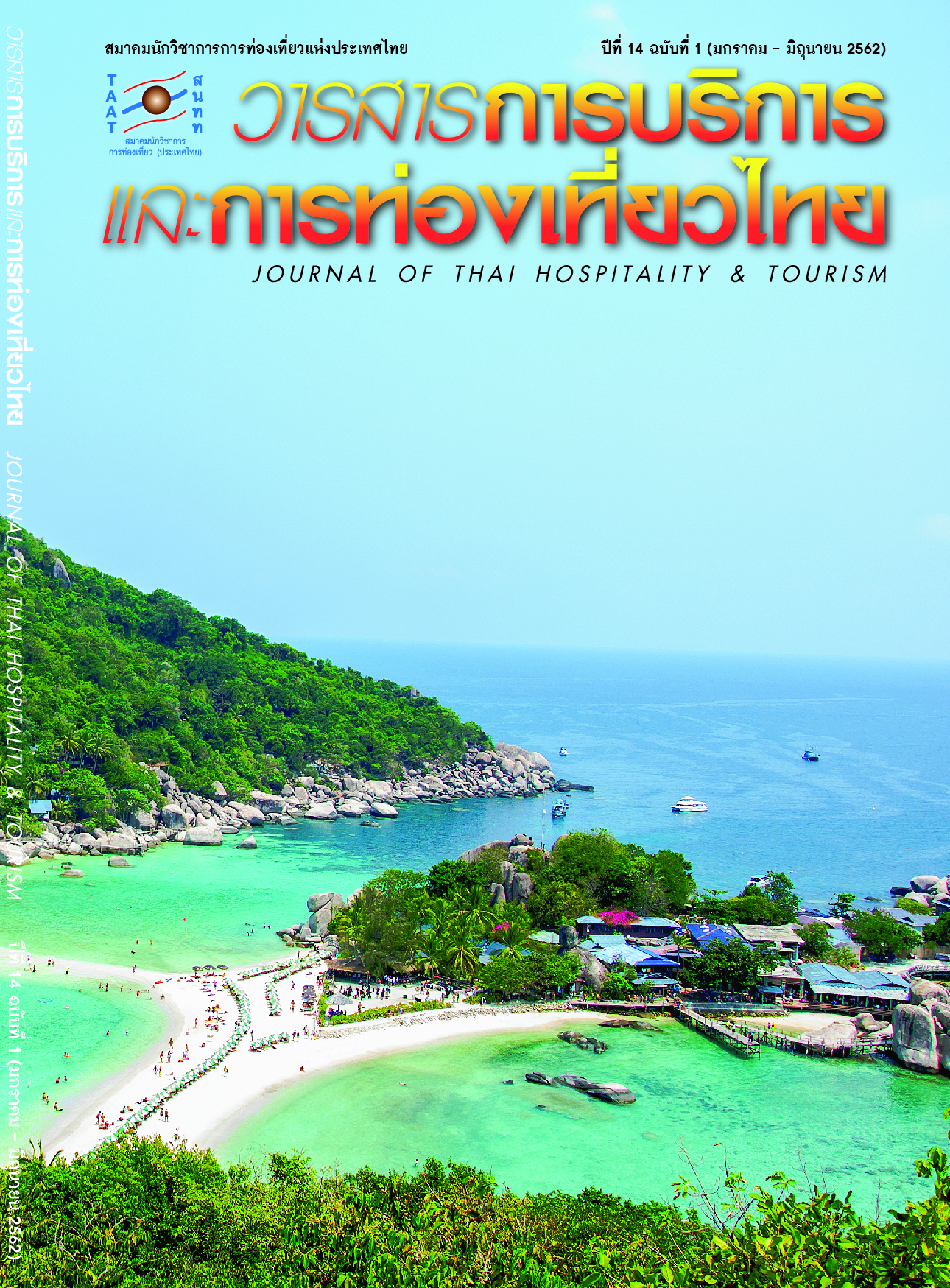Comparison between the Decision-Making Process of Russian and Chinese Tourists Traveling to Thailand
Main Article Content
Abstract
The purpose of this research were (1) to study the decision making process of Russian tourists traveling to Thailand; (2) to study the decision making process of Chinese tourists traveling to Thailand; (3) to compare the decision making process between Russian and Chinese tourists traveling to Thailand; and (4) to study the perception of travel agents towards the decision making process of Russian and Chinese tourists traveling to Thailand. This research covered both quantitative and qualitative approaches. Population and samples were 400 Chinese and Russian tourists visiting Thailand. Purposive sampling was used in collecting data together with a self-administered questionnaire. In quantitative data analysis, descriptive statistics including percentage, frequency, mean, variance, and standard deviation were utilized to analyze the data. Hypothesis tests were conducted by using statistical techniques t-test and f-test. For qualitative approach, data were collected by personal interviews of 10 travel agents targeting Chinese and/or Russian tourists. Judgment sampling was adopted along with structured interviews in collecting data.
The research results show that there is difference between Chinese and Russian tourists in Information search factor, Evaluation of alternatives factor, Post-purchase decision factor at the 0.01 significant level; whereas, there is no difference between Chinese and Russian tourists in Purchase decision factor at the 0.01 significant level. Finally, the author has recommended five strategies: (1) focusing on novelty seeking dimension; (2) developing referral programs, and partnership with tour operators in their home country to guarantee numbers of tourists, as well as providing special promotions for Thai tour companies supporting Thailand tourism; (3) emphasizing on Thailand natural beauty, weather, cost-value relations, overall costs of the trip, different culture, and a variety of tourist attractions; (4) developing travel programs that suit tourists’ needs and behavior and bundle some products together to show cost-value relations; and (5) maintaining goodwill of people and infrastructure and beauty of tourist destination.
Article Details
References
[2] Andreason, A. (1965) Attitudes and Consumer Behavior: A Decision Model in New Research in Marketing. Berkeley: Institute of Business and Economic Research, University of California.
[3] Blythe, J. (2013). Consumer Behavior. London: SAGE Publications Ltd.
[4] Correia, A. & Pimpão, A. (2008). Decision-Making Processes of Portuguese Tourist Travelling to South America and Africa. International Journal of Culture, Tourism and Hospitality Research, 2(4), 330-373.
[5] Department of Tourism (2013). Summary of Tourists from January to December. Retrieved March 28, 2014, from Department of Tourism: http://tourism.go.th/uploads/Stat/22950.pdf
[6] Dewey, J. (2007). How We Think. New York: Cosimo.
[7] Esichaikul, Ranee. (2012). Travel Motivations, Behavior and Requirements of European Senior Tourists to Thailand. Revista de Turismo y Patrimonio Cultural. 10(2), 47-58.
[8] Howard, J. A. (1969). The Theory of Buyer Behaviour. New York: Wiley and Sons.
[9] In-touch Research & Consultancy (2013). Executive Summary of ASEAN Tourism Market Study Project Year 2013. Retrieved March 31, 2014 from Tourism Authority of Thailand: https://etatjournal.files.wordpress.com/2014/02/asean_market.pdf
[10] Israel, Glen D. (1992). Determining Sample Size (IFAS Report PEOD6). Retrieved from University of Florida, Institute of Food and Agricultural Sciences Extension: http://edis.ifas.ufl.edu/pd006.
[11] Jun, L. (2010). Chinese Tourists’ Behavior in Chiang Mai Province, Thailand, Master thesis, Recreation and Tourism Management Major, Faculty of Liberal Arts, Mae Jo University.
[12] Kotler, P. A. (2010). Marketing Management. New Jersey: Pearson International.
[13] Lovelock, C. & Wirtz, J. (2011). Service Marketing – People, Technology, Strategy. New Jersey: Pearson Internal.
[14] Nicosia, F. (1966). Consumer Decision Processes. Englewood Cliffs, New Jersey: Prentice-Hall.
[15] Oxford Business Group (2014). Thailand Targets New Tourism Source Markets. Retrieved May 1, 2014, from Economic Update: http://www.oxfordbusinessgroup.com/economic_updates/ thailand-targets-new-tourism-source-markets
[16] Sangpikul, Aswin. (2009). An Analysis and Comparative Study of Travel Motivations and Travel Behaviors of International Tourists to Thailand. Bangkok: Dhurakij Pundit University.
[17] Swarbrooke, J. A. (2001). Consumer Behavior in Tourism. Oxford: Butterworth-Heinemann.
[18] Tourism Authority of Thailand (2013). Thailand: Travel & Tourism Economic Impact 2013. Retrieved May 1, 2014, from World Travel and Tourism Council: http://www.wttc.org/site_media/uploads/ downloads/thailand2013.pdf
[19] Tourism Authority of Thailand (2014). About Thailand: Economics and Politics. Retrieved May 28, 2014, from TAT: http://www.tourismthailand.org/Thailand/economy
[20] World Tourism Organization (2014). UNWTO Tourism Highlights, 2014 Edition. Retrieved January 1, 2015, from UNWTO: http://www.e-unwto.org/doi/pdf/10.18111/9789284416226
[21] Yamane, T. (1967). Statistics, An Introductory Analysis, 2nd Ed., New York: Harper and Row.
[22] Zikmund, W. G. (2003). Business Research Methods. Cincinnati, OH: Thomson/South-Western.


